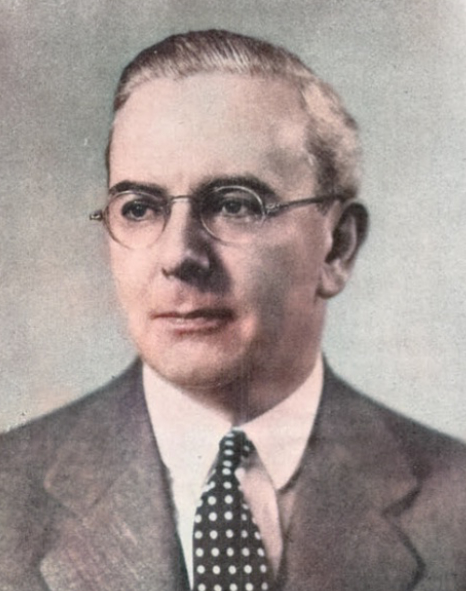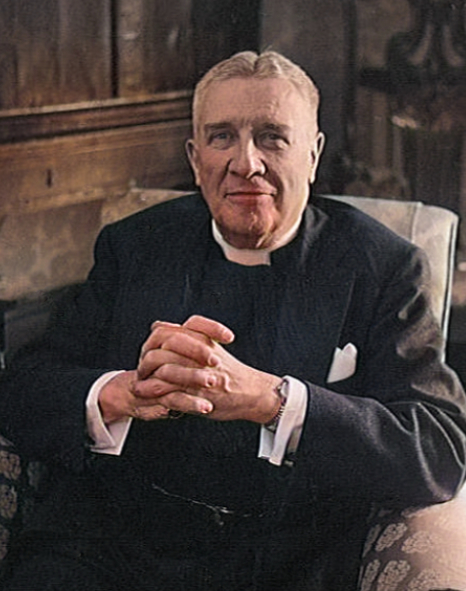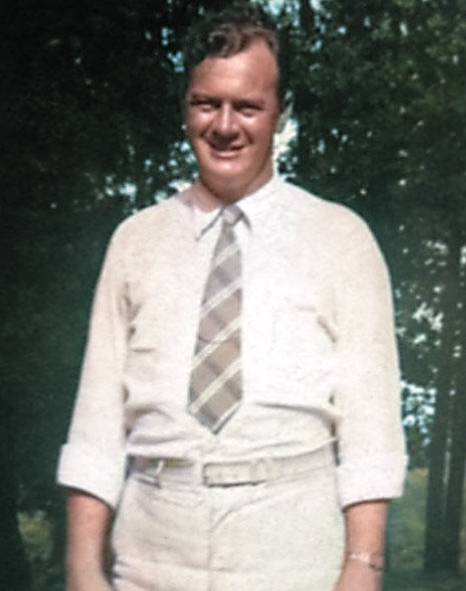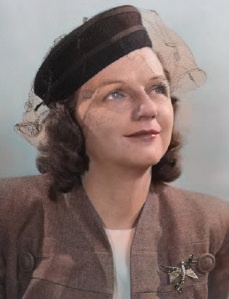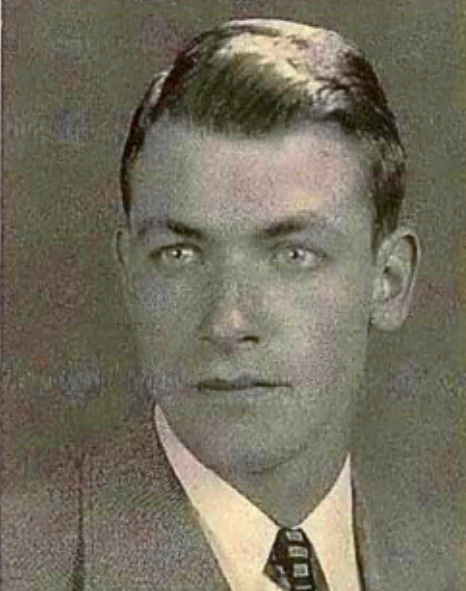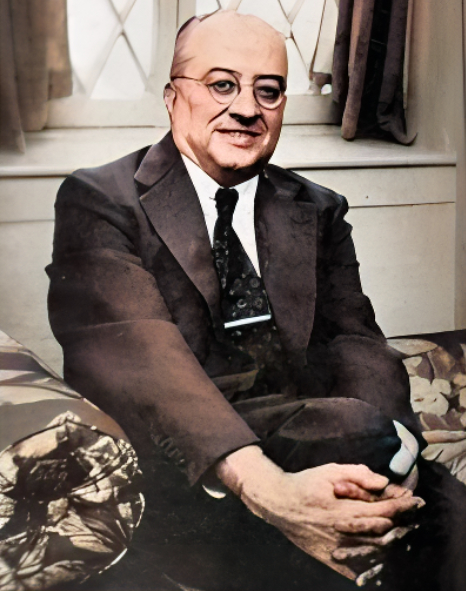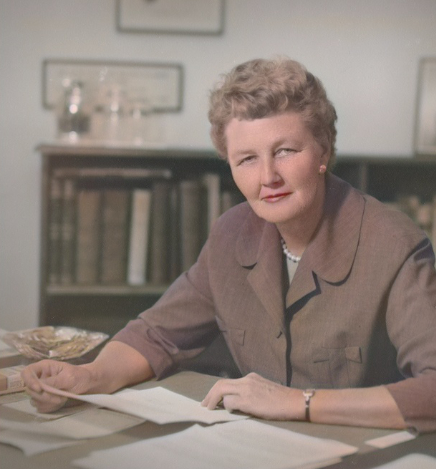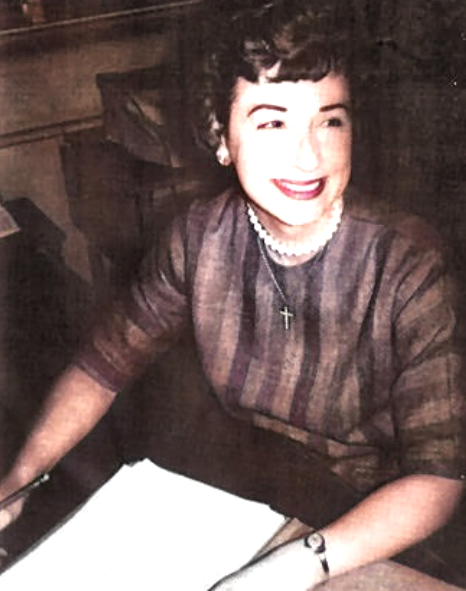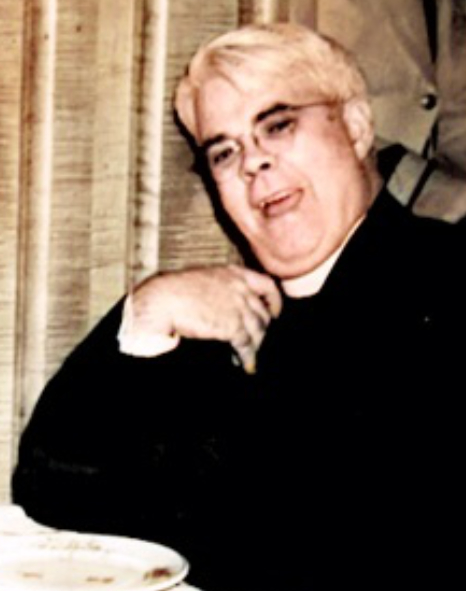

"I would like to just spin some yarn and they will be a series of yarns which cluster
around the preparation of the good old A.A. bible and when I hear that, it always makes me shudder, because the guys who
put it together weren’t a damn bit biblical. I think sometimes some of the drunks have an idea that these old timers went
around with almost visible halos and long gowns and they were full of sweetness and light. Oh boy, how inspired they were,
oh yes. But wait till I tell you."
- Bill Wilson - Texas State AA Convention - Fort Worth TX ~ 12 June 1954
Early roots of Alcoholics Anonymous began in New York and Akron areas. The people included on this page are grouped by the New York area, the Akron area, and other areas. They are listed in chronological order as much as possible. Due to the size of the page it has been separated into individual pages by area. To jump directly to a bio click on the name. On this website, the full names of members of anonymous groups are listed if they are currently deceased; non-members of anonymous groups are referred to with their full names.
Individuals located in the New York area
William Griffith Wilson (1895-1971)
Bill was born in Vermont and raised by his grandparents. When Pancho Villa invaded the United States in 1916, Bill was activated, along with his entire school class, in the Vermont National Guard but was not deployed to the US Border. The next year he became a commissioned artillery officer. During his military training in Massachusetts he took his first drink. This he wrote was "the elixir of life". Soon he was drinking until he would pass out. In 1918 he married Lois, shortly before he was deployed in World War I as a 2nd lieutenant in the Coast Artillery and stationed in France. Returning after the war his drinking evolved which combined with the Stock Market Crash of 1929, and his bouts of depression, he and wife Lois found themselves without a solution for living. Eventually Bill discovered the solution to his drinking was through a spiritual experience, involvement with the Oxford Group, and working with fellow drunks.
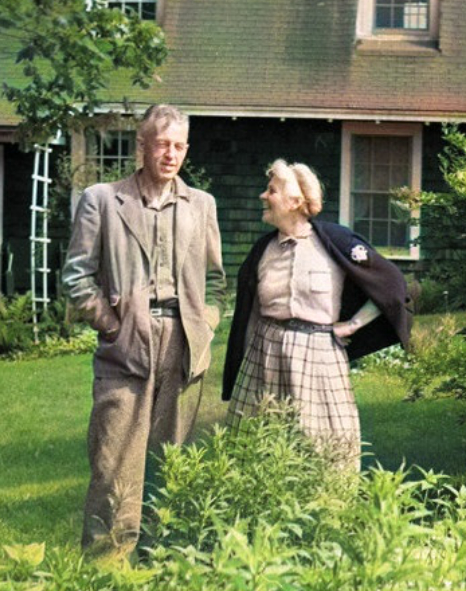
Lois Burnham Wilson (1891-1988)
The co-founder of Al-Anon and married to Bill Wilson. Lois was there from the beginning working the program along side her husband Bill. Lois was the oldest of 6 children, her father a surgeon in Brooklyn NY. Her grandfather was a prominent pastor and scholar in the Swedenborgian Church, a church Lois was raised in. The affluent Brooklyn Heights family spent their summers at their summer home in Vermont. Her brother Rogers was friends with a Vermont local boy, Bill Wilson. When Lois first met Bill she was engaged, so meeting Bill presented her a challenge. Lois quickly made a choice, one that would completely changed her life. Lois and Bill were married a few months before Bill was deployed to Europe for WWI.
Lois' complete life story is presented in the book "The Lois Wilson Story: When Love is not Enough, The Biography of the Cofounder of Al-Anon" by William G Borchert 2005. The book was the basis of the movie "When Love is Not Enough: The Lois Wilson Story" 2020. Also Al-Anon published her memoir in "Lois Remembers".
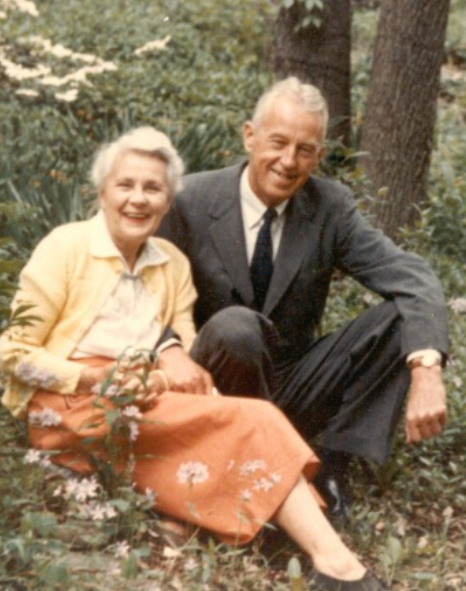
Edwin Throckmorton Thatcher a.k.a. "Ebby" (1896-1966)
Ebby was a childhood friend and drinking companion of Bill Wilson. Ebby was the son of a prominent New York family from Albany, that summered in Manchester, Vermont. The family had made their wealth manufacturing iron cast stoves. Their summer home was close to the boyhood home of Bill Wilson, in East Dorset. A newspaper article reports Ebby attended school in Manchester during the winter of 1912. A later newspaper article reported Ebby had stayed with Lois and Bill Wilson, along with Lois' two brothers in June of 1929 at the Burnham summer home in Manchester, VT. Considered a chronic alcoholic, Ebby was on the verge of being committed to a Vermont Asylum in 1934. Just before sentencing, he received a jail house visit from Rowland Hazard, a sober member of the Oxford Group, and two other Oxford Group members. Rowland spoke of the relief he had found from alcoholism through the Oxford Group. One of the Oxford members, Cebra Graves, was the son of Collins Grave, the Magistrate in charge of Ebby's case. Collins was to sentence Ebby the next week. His intention was to sentence Ebby to the Vermont Asylum for the Insane. Collins agreed that if Cebra could show up Monday in court with a sober and clean Ebby, he would release Ebby into their care to take to New York City. On Sunday Cebra along with Shep Cornell, another Oxford Group member, found Ebby drunk on his back porch. They convinced him he needed help. He agreed to go with them. They found a tailor willing to work on Sunday, got his suit cleaned, and fed him enough coffee for him to appear sober at court session on Monday. As a result Ebby was placed in their custody, and taken to Calvary Mission, the rescue mission attached to Calvary Church in New York City. There Ebby found sobriety through the Oxford Group. In November of 1934 Ebby visited with Bill and Lois at their Brooklyn home and introduced Bill Wilson to the principals of the Oxford Group. Bill & Lois eventually started attending Oxford Group meetings after Bill sobered up in Towns Hospital. They started hosting Oxford Group meetings in their Brooklyn home, which soon attracted other struggling alcoholics. This group referred to themselves as the "drunk squad". Ebby, through the years, struggled to maintain continuous sobriety. From an October 1999 interview with Searcy Whaley, he stated the following concerning Ebby, "But six months after he (Ebby) gave Bill a clue on how to stay sober, Ebby went back out in the Bowery in New York City and had stayed drunk on and off for eighteen years. Then in early 1953 Bill Wilson came to Dallas. By then I was head of a clinic that took wet drunks. Bill and I had lunch, and after that lunch I asked Bill, “What would you rather see happen now that’s never happened in AA before?” and without any hesitation he said, “I’d rather see Ebby have a chance to get sober. Bill said that it as if to say, “You sober Ebby up” – that’s the way I took it. Bill didn’t even know exactly where Ebby was, but a couple of mutual friends found him on the Bowery. They dried him out a bit but gave him a pint of whiskey to get on the plane with, and he flew to Dallas to sober up. Ebby was in bad shape physically, mentally, spiritually and every other way you could imagine after being drunk for the better part of eighteen years and sleeping on the streets. And he was very unruly. He cussed out Bill and Dr. Bob and me and everybody else. Ebby was still very resentful because he could have been one of the forefathers of AA. But finally, Ebby asked if he could go to a meeting with me, and we went over to the Dallas Suburban AA Club – he got sober and stayed that way. And he got to helping others; we got him a job and he did pretty good. He stayed 4 or 5 years before going back to New York. But his health was failing him and he fell off the wagon again. Of course Bill was in touch with him all the time, and he made arrangements for Ebby to go to a halfway house in upstate New York. The lady up there that ran it said she would gladly take care of him. He went up there in 1963 and in 1966 he died. Lois Wilson told me unequivocally that Ebby was sober 2½ years when he passed away." Ebby died in 1966 from emphysema.
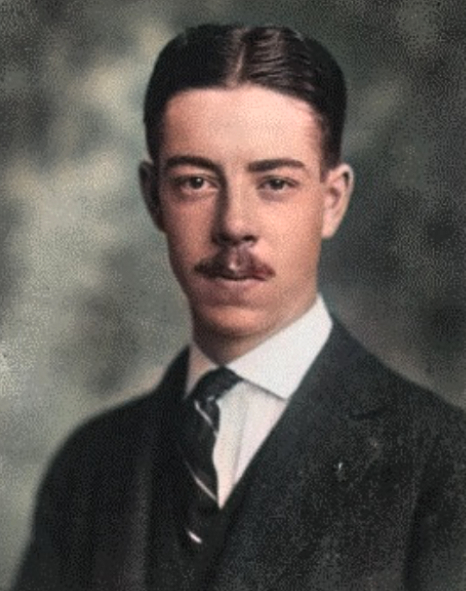
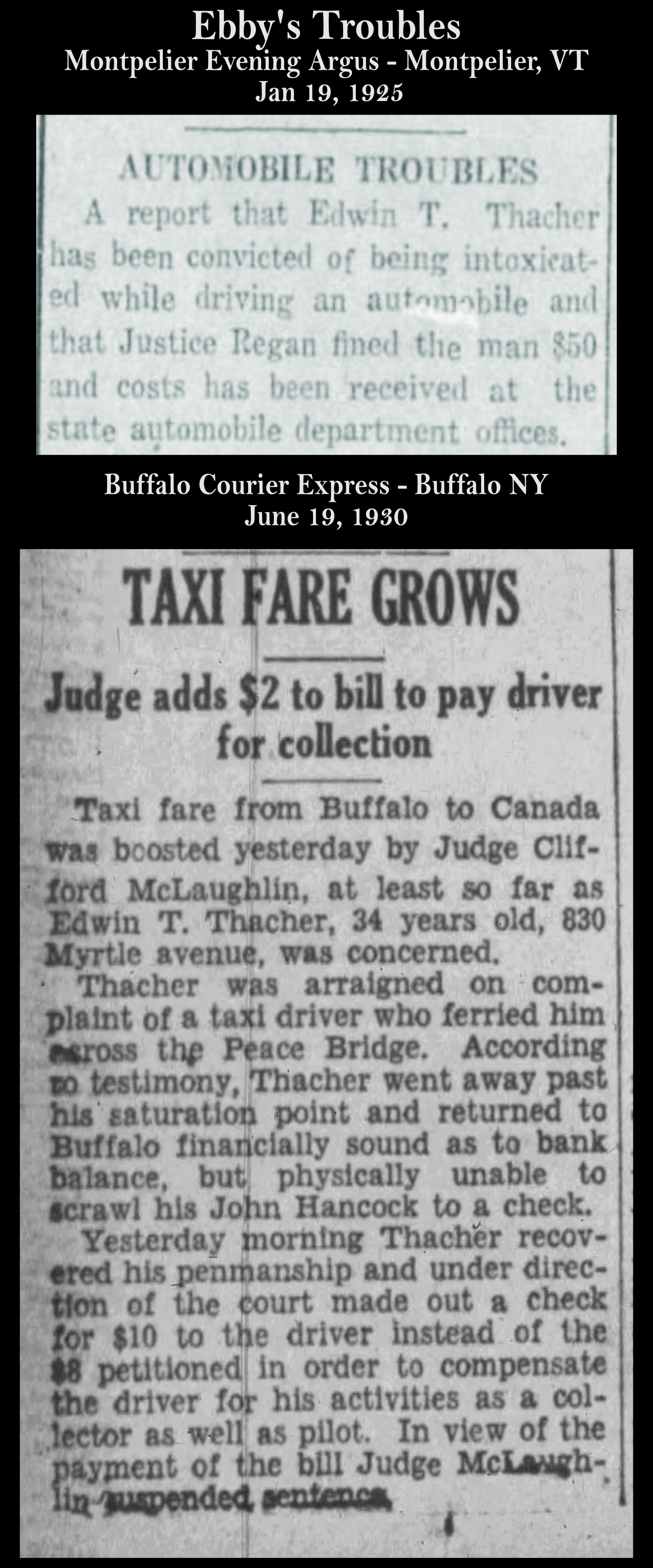
become astonishingly difficult to solve"
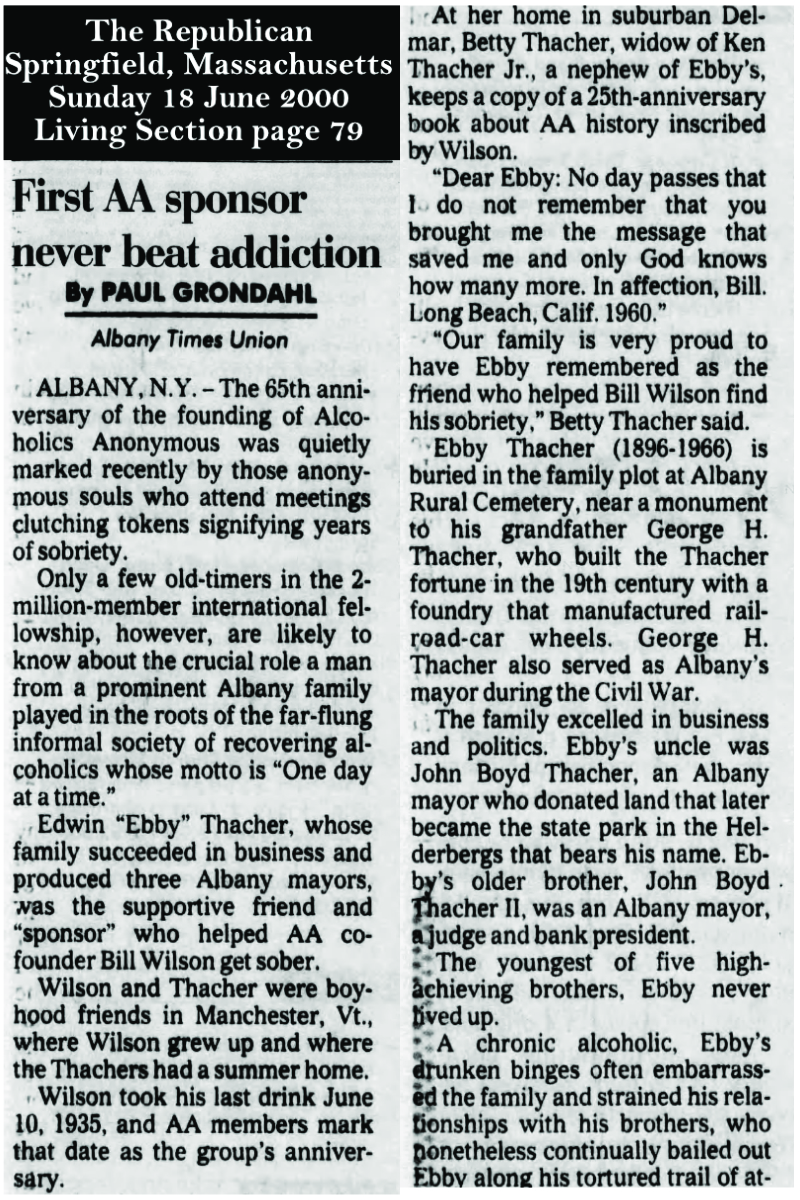
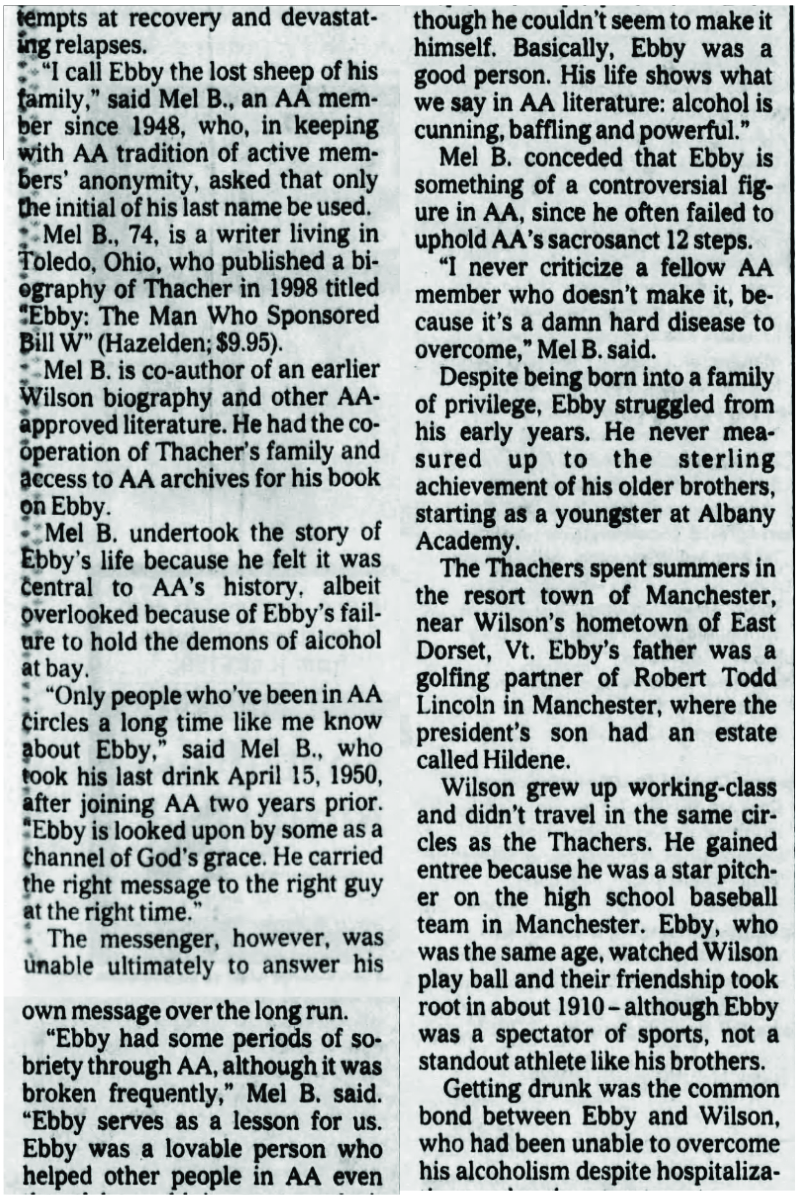
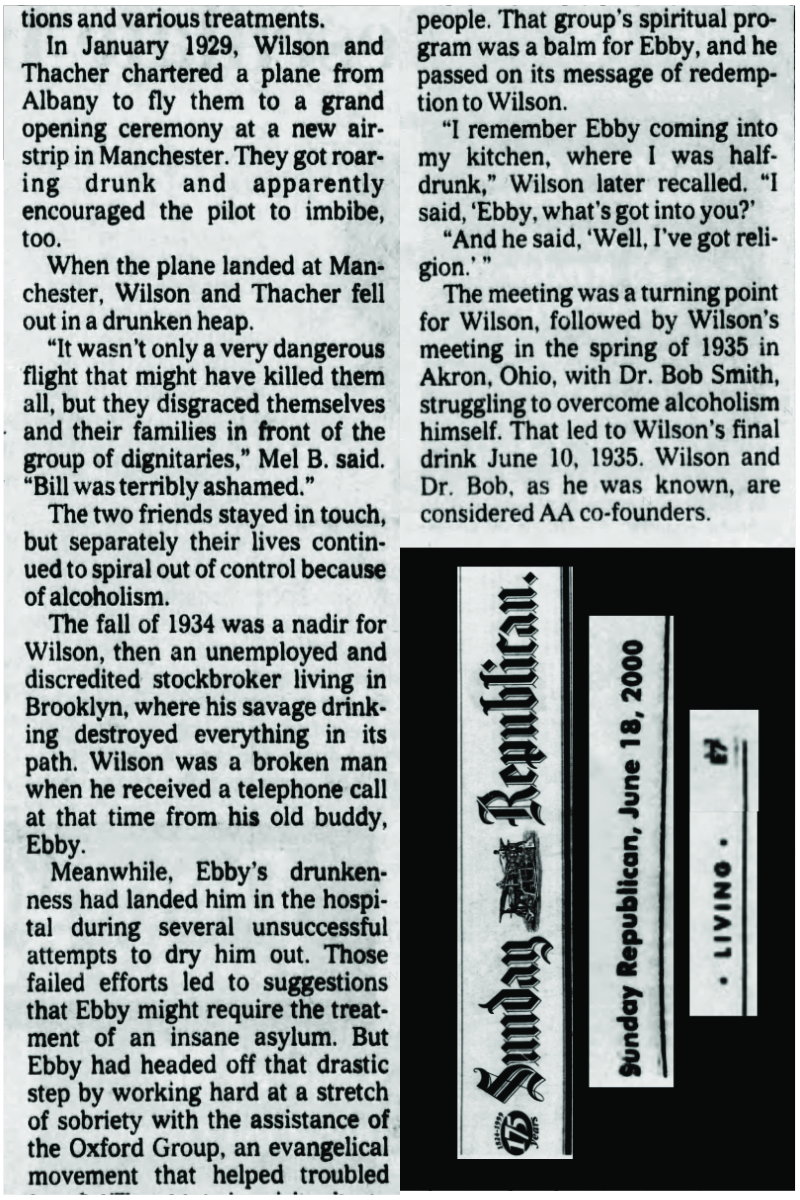
Carl Gustav Jung (1875-1961)
Dr Jung was a Swiss psychiatrist, psychotherapist and psychologist. He collaborated with Sigmund Freud. When Rowland Hazard was not accepted as a patient of Freud, he went to Jung's clinic in Zürich, Switzerland. After treatment and thinking he was cured of his dependency on alcohol discovered he did not after drinking on the ship back to New York. Returning to Jung he was told his only hope was to have a "vital spiritual experience". Jung also mentioned Rowland's current affiliation with church would not suffice. Carved above the door of his house were the words "Bidden or not bidden, God is present".
“Alcohol is the reduced form of spirit. Therefore, many people, lacking spirit, take to drink. They fill themselves with alcohol.”
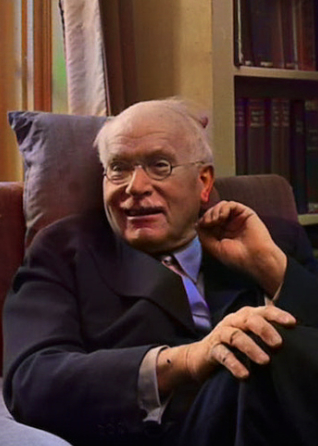
Rowland Hazard III (1881-1945)
Rowland Hazard III was born into an affluent family in Rhode Island. Rowland was a Yale graduate. Seeking relief from his chronic drinking Rowland traveled to Europe for help. After spending time under the care of Dr Carl Jung he traveled back to the US but began drinking again before the ship had reached port. Rowland returned to Jung only to be advised his his only hope was to have a transformational spiritual experience. Rowland returned to the United States, sought out and became involved in the Oxford Group. Here he found relief. In August of 1934 Rowland was entertaining two other Oxford Group members, Shepard Cornell, and Cebra Graves, at his summer house in Glastenbury, Vermont. Hearing that Ebby was in jail and going to be committed to the Vermont Asylum for the Insane the three friends spoke with the magistrate before the sentencing. The magistrate happened to be Cebra's father. Hearing the groups plan convinced the magistrate to parole Ebby into their custody. They took Ebby to Manhattan, where he was placed in the Calvary House, the mission run by Calvary Church, then pastored by Sam Shoemaker. From there the now sober Ebby made a visit Bill and Lois Wilson at their home in Brooklyn. Bill Wilson describes the events in his story in the book Alcoholics Anonymous. Rowland never became a member of AA but due to his actions with Ebby, the message was carried to Bill Wilson. Dr Jung during a talk he gave in 1954 referred to Rowland without giving his identity. More recent research points to Rowland's treatment by Jung sometime in 1926. Rowland appears to have had several relapses after his encounter with Jung. He joined the Episcopal Church in 1936, and remained active for the remainder of his years. Rowland was able to achieve a productive business career. Although Rowland never joined AA his actions with Ebby became the path the message took on it's way to a desperate Bill Wilson and millions of others.
The information above was taken from multiple articles from the 2006-2007 issues of
Culture Alcohol & Society Quarterly Newsletter Vol. II, No. 7
Culture Alcohol & Society Quarterly Newsletter Vol. II, No. 8
Culture Alcohol & Society Quarterly Newsletter Vol. III, No. 2 from the
collection at Brown University Library.
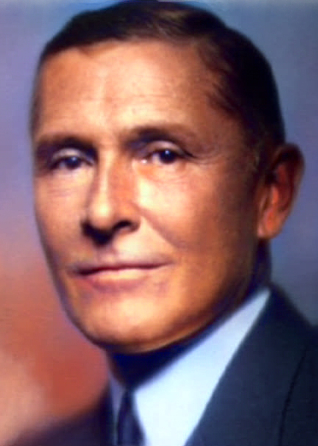
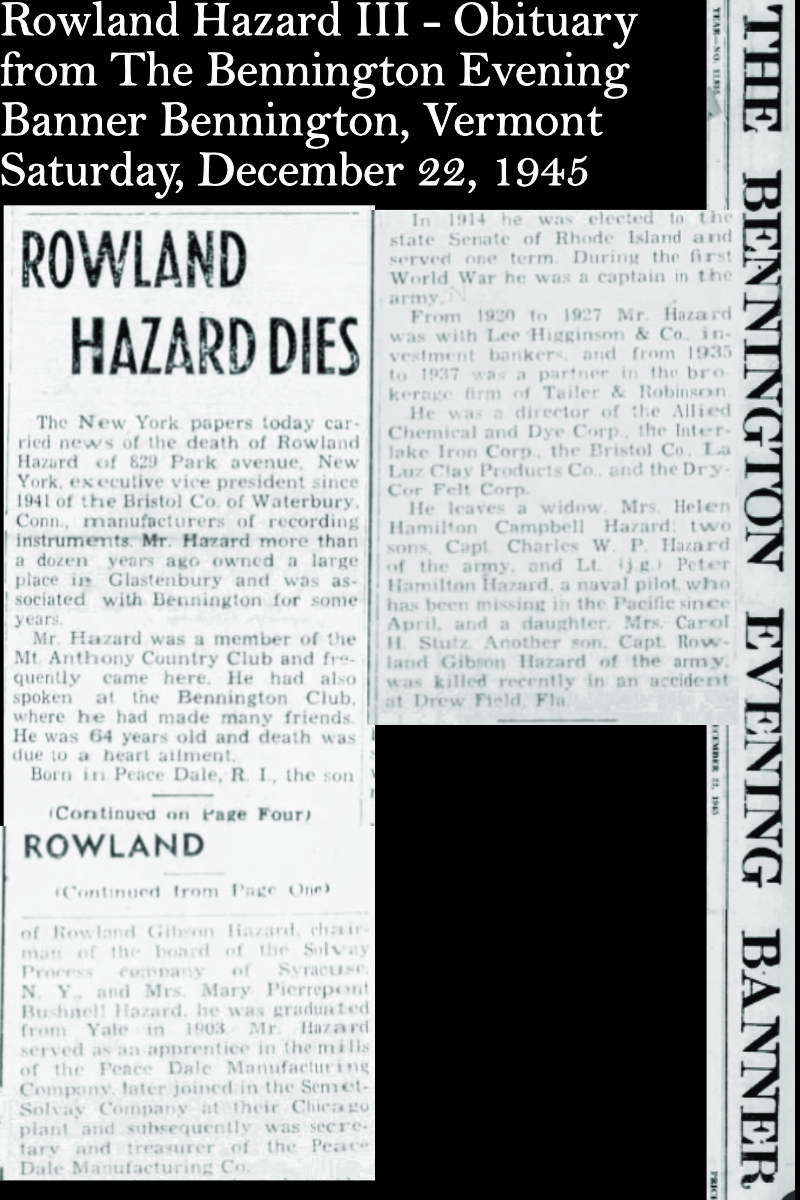
Cebra Graves (1898-1979)
Cebra Quackenbush Graves 26 Aug 189a8 - 1 Jan 1979. Cebra went by the family nickname Cebe, Quackenbush was his mothers maiden name. He had an acting career on Broadway which ended in 1927. He attended Williams College for one year then enlisted in the US Army and served during WWI in France. In 1924 he attended Columbia and acted on Broadway for a few years. He served as the Vermont State Attorney and then as a State Senator He returned to Vermont and was reading law in his father's firm in Bennington. At the age of 36, Cebra first met Rowland Hazard at a party held by Cebra's parents in 1934. A few days after the party Cebra and his father got into a heated argument with his father over his behaviors. Cebra's reaction was to walk out of the family business and start walking down the road towards Williamstown Massachusetts. Rowland happened to be driving that day and spotted Cebra walking. He stopped and asked Cebra where he was walking to. Cebra replied he did not know. Rowland got him into his car and drove to the house of his Oxford Group friend Professor Philip Brown. As they three were talking the subject of alcoholism came up and the two guaranteed Cebra if he would follow the principals of the Oxford Group he would not drink alcoholically. Cebra, in his 1954 discussion with Bill Wilson, said during this discussion Roland told him he had taken a bottle along with him on a road trip. Rowland heard a voice saying to him, You will never take a drink again. He reacted by throwing the bottle into the bushes. As a result of the conversation Cebra began attending meetings, he toned down his drinking and moved back to NYC. There he attended Oxford Group meetings, returning to what he considered was normal drinking. In August of 1934 he went back to Bennington Vermont, tried to make amends to his parents, and live by the Oxford Group principals. While back home Cebra's father, the acting magistrate, had heard Ebby's case and had not yet sentenced him. The intent was to send him to the Vermont Asylum for the Insane. Cebra had known Ebby as a golfing and drinking friend for years. Cebra and Rowland visited with the magistrate, explained the Oxford Group principals and ask him not to send Ebby to jail. Rowland and Cebra's father was closer in age, than Rowland was to Cebra. Cebra's father said he would make Rowland and Cebra responsible for Ebby. On a Sunday afternoon Cebra visited Rowland at his house in Glastenbury. That same weekend Shep Cornell, a friend of Rowland's and an active Oxford Group member at the time was also visiting. As the three set around Rowland's swimming pool discussing carrying the Oxford Group message to others. Cebra brought up Ebby Thatcher, and proposed they visit Ebby that afternoon. Shep and Rowland were skeptical but Cebra persisted and finally convinced Shep to go with him to Ebby's house. The two found Ebby filthy and drunk on the back porch. Cebra walking up asked "You having fun yet?" with Ebby's reply "Go to hell". Cebra answered "You don't have to live like this anymore". The two took Ebby down to Manchester Center, found a tailor to clean Ebby's only suit, got Ebby cleaned up, and took him to a restaurant where they shared their experiences in the Oxford Group. Ebby agreed to go to NYC, move into Calvary House, and start attending meetings.
Although Cebra carried the message to Ebby, he still continued to struggle with his drinking. In 1940 he came to AA but did not get sober until 1954. In a 1954 interview with Bill Wilson Cebra told of making a comment at an Oxford Group meeting after seeing an attractive young lady in the room, "there's a good looking doll". The was informed he was offending the law of Purity, to which he responded "Purity, I joined this outfit to get over a hangover". He remarked in his interview with Bill that he had not done well with the rarefied spiritual atmosphere of the Oxford Group. He once told his son that his desire for alcohol wasn't a thirst, it was a hunger. He said he first learned of AA in 1940 after he was hypnotized in an effort to get over drinking, then immediately got drunk again. He met an old friend whose husband had died from cirrhosis and other conditions as the result of his drinking. She mention a common friend who had not had a drink for several years. Cebra contacted him and he introduced him to a man named Bert T. Cebra went to see Bert and together they went to the AA clubhouse on 24th Street. He mentioned he saw Ebby there that night. During WWII Cebra served in the Navy, working his way to the rank of Lt. Commander. When discharged he used his G.I. Bill to go to Columbia School of General Studies and then the Columbia Graduate School receiving a BA and MA in Classics. From 1946 to 1951 he was an Instructor in Classical Studies (Humanities) in Columbia School of General Studies. He was married 5 times, after the death of his forth wife, he looked up an old girlfriend he had known in France during the 1920's. The two married, and he lived the rest of his life with her in France. After spending some time with Bill Wilson in 1954 he return to France and continued in AA. He remained sober until his death. He died of a lung complication in France at the age of 80.
The information above was taken from multiple articles from the 2006-2007 issues of the Culture Alcohol & Society Quarterly Newsletter at Brown University Library;
Culture Alcohol & Society Quarterly Newsletter Vol. II, No. 7
Culture Alcohol & Society Quarterly Newsletter Vol. II, No. 8
Culture Alcohol & Society Quarterly Newsletter Vol. III, No. 2,
Culture Alcohol & Society Quarterly Newsletter Vol. III, No. 3,
Culture Alcohol & Society Quarterly Newsletter Vol. III, No. 4,
Culture Alcohol & Society Quarterly Newsletter Vol. III, No. 6,
Culture Alcohol & Society Quarterly Newsletter Vol. III, No. 7.
and
Culture Alcohol & Society Quarterly Newsletter Vol. III, No. 8.
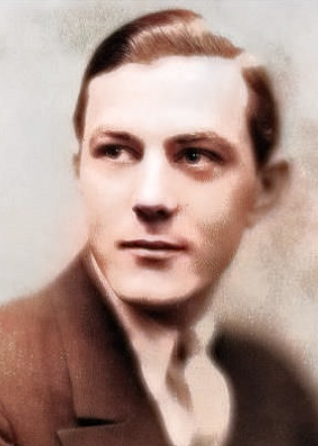
Shep Cornell (1899-1985)
Francis Shepard "Shep" Cornell was born in Montclair, New Jersey. In 1917 he served in the US Army during WWI. After discharge attended Lehigh University from 1919-1923. He became a Sales Engineer with Union Carbide in NYC. He then became a partner in several NY Stock Exchange firms. When Shep married his second wife in 1933, the pastor that married them was involved with the Oxford Group. Shep became active in the Oxford Group. In August of 1934 Shep was visiting Rowland Hazard at his home in Glastenbury, Vermont and there met Cebra Graves. His involvement with Ebby is described in other sections of this page. Lois Wilson remembers that during 1935 herself, Bill, Ebby and Shep were regularly attending Oxford Group meetings together. Shep attended some of the meetings that Bill and Lois held at their home in Brooklyn. In 1940 he ran for US Congress Representative to represent Upper Manhattan and Harlem, but lost. He enlisted in the US Army Air Corps in 1943 as a Captain, served states side and when discharged held the rank of Lt. Colonel. After the war he joined A.O Smith and moved to Milwaukee where he was the executive assistance to the president of A.O. Smith, where he remained until his retirement in 1964. After retirement he and his wife bought a farm near Charlottesville VA and raised cattle. During retirement he served on multiple corporate boards. On the way home from a football game in 1985, Shep had a heart attack and died while driving. This caused the car to hit a tree, with his wife escaping with minor injuries. Shep was 86 years old at the time of his death. He was affiliated with the Episcopal Church the rest of his life. There is no evidence he ever participated in AA. But obviously he was used, during this time of participation it the Oxford Group, to carry the message to Ebby Thatcher.
The information above was taken from multiple articles from the 2006-2007 issues of Culture Alcohol & Society Quarterly Newsletter, at Brown University;
Culture Alcohol & Society Quarterly Newsletter Vol. II, No. 7,
Culture Alcohol & Society Quarterly Newsletter Vol. II, No. 8,
Culture Alcohol & Society Quarterly Newsletter Vol. III, No. 2, and
Culture Alcohol & Society Quarterly Newsletter Vol. III, No. 8.
Also used was the article on Shep in the 1960 edition of The National Cyclopaedia of American Biography page 358.
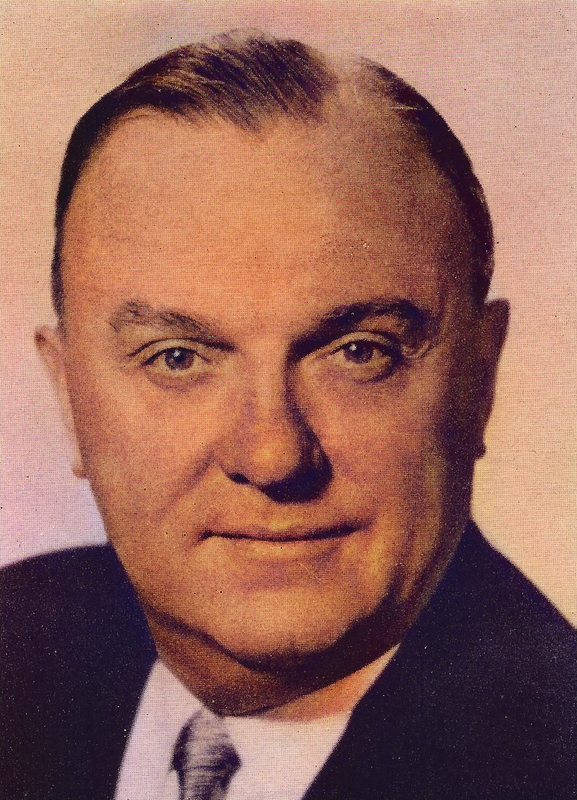
Charles Barnes Towns (1862-1947)
Charles established the Charles B Towns Hospital in 1901, located at 293 Central Park
West in Manhattan. Charles came to New York in 1899 to establish a brokerage business in which he was a partner. By 1901 the brokerage had
failed. Charles, not a doctor, claimed he had been approached by an unidentified person who claimed discovery of a cure for alcoholism and
drug addictions. This person suggested Towns could make money by providing this cure to the public. As a result, Towns placed ads for
"drug fiends" looking for relief. This claim was cutting edge at the time. Prior to this no real hope existed for alcoholics. In 1840,
six drunkards in a bar in Baltimore made vows to each other to help each other stop drinking. This vow evolved into the Washingtonian movement,
which grew to an estimated 600,000. Over time the group became politically involved in prohibition, abolition, and a variety of other social issues.
This lost of focus, one drunk keeping another dry, is generally recognized as its demise. AA used lessons learned from the Washingtonians,
when the 12 Traditions were written. After the Washingtonians, came the New York State Inebriate Asylum,
located in Binghamton. It was the first institution designed and constructed to treat alcoholism as a mental disorder in the United States.
The facility operated from 1864 through 1879. It was then converted to a mental hospital. At the same time like facilities
operated in Long Island, Philadelphia, San Francisco, Boston, and Chicago.
In 1908 Charles Towns was sent to China as a United States
Drug Treatment Ambassador to assist with the opium crisis. There Towns claimed a 90% success rate based on the fact he never heard from
90% of his patients again. While in China he perfected his treatment regime. Although Towns was not a medical doctor, he did employ doctors
and a medical staff at his facility. His method, the Belladonna Cure, was named after a the belladonna plant.
Belladonna is commonly called deadly nightshade, and all parts
of it are poisonous. Some of it's effects on the human body include changes to saliva, sweat, pupil size,
urination, digestive functions, increased heart rate, and increased blood pressure. At the beginning of the treatment, a mixture of compounds,
including morphine, were given to induce sleep. Once asleep, patients were woke each hour and given the Belladonna regimen. The regiment consisted
of a mixture of deadly nightshade, another plant in the nightshade family called henbane, and prickly ash. The mixture was given every hour for
two days, followed by a dose of castor oil. Every 12 hours, a compound mixture, including mercury, was taken. In addition, some received
small amounts of strychnine. Hopefully the patents bed sheets were changed on a regular basis. The hospital catered to an affluent clientele,
with payment arranged before treatments began. Dr. Silkworth was the hospital's Chief of Staff during the times that Bill Wilson was a patient.
Dr. Silkworth is mentioned in the chapter "The Doctor's Opinion" in the Big Book. Bill was admitted three times between 1933 and 1934 for detox.
In November 0f 1934, Bill received a visit from his old friend Ebby Thatcher who shared his success in the Oxford Group. Bill was somewhat
interested in the group but soon after was admitted again to Towns Hospital for his forth stay. This time he exhibited the signs of delirium tremens,
so was given the Belladonna Cure. During this stay Bill lying in bed depressed and despairing, cried out, "I'll do anything! Anything at all!
If there be a God, let Him show Himself!" He then experienced a sensation of bright light, a feeling of ecstasy, and a new serenity. He never drank
again for the remainder of his life. Wilson described his experience to Silkworth, who told him, "Something has happened to you I don't understand.
But you had better hang on to it".
This time Bill maintained his sobriety through participation in the Oxford Group and working with other alcoholics.
Bill would return to the hospital to talk with others taking the treatments.
When he began writing the book Alcoholics Anonymous, Charles Towns lent Bill money to help him publish the book, almost 50% of what was raised
came from Charles. Charles was the person that had contacts with Liberty Magazine, resulting in the article "Alcoholics and God" in the September
30, 1939 issue. Bill was not overly satisfied with the article, feeling the emphasis on God would cause many to dismiss AA as a solution.
The article provided the first publicity for AA, which resulted in over 800 letters received at the NY AA office, and included orders for about
200 copies of the Big Book. Charles Towns offered Bill a paid position on the hospital staff to work with alcoholic patients, but when this opportunity
was presented to the other early New York AA members, they disapproved, so Bill passed on the offer. Charles Towns, although often overlooked by
historians, was instrumental in the foundation of AA. A book about the life of Charles Towns written by Gary Neidhardt titled "King Charles of New York City"
is available either through a library or online.
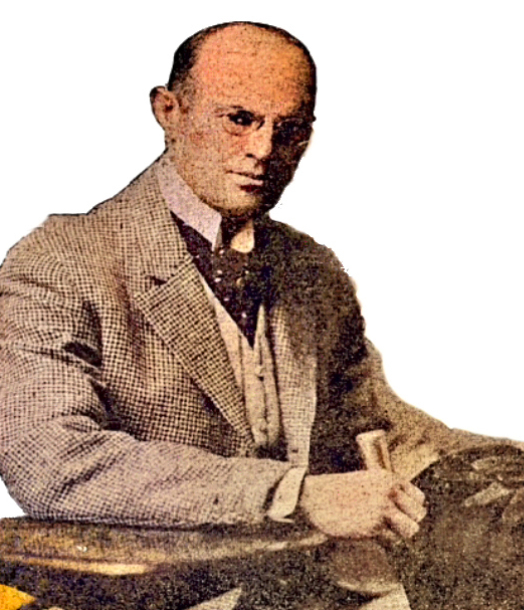
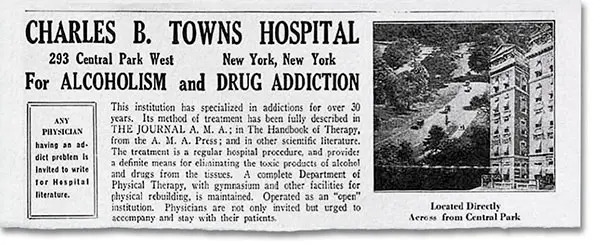
Dr. William Duncan Silkworth (1873 - 1951)
The Doctor in charge at the Charles B. Towns Hospital, when Bill Wilson was a patient. He is credited for “The Doctor’s Opinion” in the Big Book. He graduated from Princeton University with a BA. He then graduated from the Bellevue Hospital Medical College in 1899 with a MD degree. During his internship he served in the inebriate clinic” at Bellevue Hospital in Manhattan. He chose to work with alcoholic and drug dependent patients as his professional specialty. He felt that medical science at the time had failed to study alcoholism as a disease. After graduation he worked at Presbyterian Hospital but most likely left to staff cuts due to the depression. Becoming the Doctor in Charge at the Charles B. Towns Hospital, he worked with Bill Wilson during his four times of treatment there. In 1945 Silkworth, convinced the management of Knickerbocker Hospital, in upper Manhattan, to establish a clinic for treatment of alcoholics. This was the first time alcoholics could be admitted to a hospital for treatment, up to that time they were only admitted with false diagnoses as alcohol addiction had been considered a moral failure. Dr. Silkworth died at his home in Manhattan on 22 March 1951, after suffering a heart attack. Collections of donations from members of AA helped to provide for his widowed wife's retirement years.
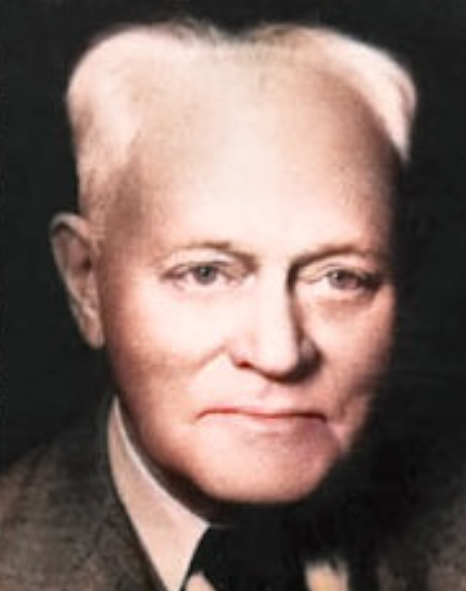

|
Silkworth: The Little Doctor Who Loved Drunks by Dale Mitchel, published by Hazelden - (not hosted on this site) |

|
Kaytar (AA) of NJ - Worked as a nurse with Dr. Silkworth at Knickerbocker Hospital |
Frank Buchman (1878 - 1961)
raw dump needs work - Frank was the son of a saloon owner in Allentown, Pennsylvania. He attended college, then seminary, and became active in church work. Through this work, he established a hospice for underprivileged boys in the slums of Philadelphia in 1905. In 1907, his board of directors asked him to reduce costs by cutting the food budget. Frank disagreed, which resulted in his board relieving him of his duties. In 1908, Frank traveled to England, still nursing his pain from losing his work at the hospice. After a year of travel, hoping to meet the evangelist F.B. Meyer, Frank attended a conference, but Meyer did not show.
insert rest of Frank's story here raw dump needs work - Frank was the son of a saloon owner in Allentown, Pennsylvania. He attended college, then seminary, and became active in church work. Through this work, he established a hospice for underprivileged boys in the slums of Philadelphia in 1905. In 1907, his board of directors asked him to reduce costs by cutting the food budget. Frank disagreed, which resulted in his board relieving him of his duties. In 1908, Frank traveled to England, still nursing his pain from losing his work at the hospice. At this point in Frank's story, we depart from the most widely seen accounts across various 12-Step resources. In 1921 Frank traveled to Keswick England. Keswick hosts an annual convention. The first one began in 1875. The convention has been held every year since, only skipping during world wars. This convention is still held annually and has grown from the original week long event into three. , which he hoped to meet the evangelist F.B. Meyer who was to appear at a conference near Oxford University. Frank attended the conference, but Meyer did not show. One of the speakers that year was Jessie-Penn Lewis. Jesse was a well-known female Welsh evangelist. As she delivered her message evangelist, but research into her life does not support this. She traveled the world, was at the epicenter of the Welsh Revival on 1904. and had a great impact on During her talk, he realized he was dragging the hated board members with him everywhere he traveled. As she talked, Frank recognized his responsibilities in the situation with the board. As he released the resentment, he found new spiritual freedom had replaced it. Sharing this fresh experience with an Oxford student, they both were unaware the foundation of an unorganized first-century Christian fellowship movement was laid. This unnamed movement's birth in 1921 began that day at Oxford. In 1928, due to the lack of a name, the local press referred to this group as the Oxford Group, a name that stuck. Frank Buchman later met with F.B. Meyer, who challenged him with the question, "Do you give God enough uninterrupted time to tell you what to do?" Frank returned to the U.S. and located his work at Calvary Church in Manhattan, where Sam Shoemaker pastored. The church allowed the Oxford Group to establish its world headquarters in a portion of its building. Sam first met Frank in 1918 in China and had a direct relationship with Frank Buchman for many years. The Oxford Group was guided by four absolutes: Absolute Honesty, Absolute Purity, Absolute Unselfishness, and Absolute Love. By these all situations were judged. In one of the earliest writings about the group it tells of following six principles, these principals that influenced the development of the 12 Steps. The Oxford Group movement did not own physical buildings, as it was a movement of individuals seeking a shared spiritual experience. According to the book "What Is The Oxford Group," page 3, "You cannot belong to the Oxford Group. It has no membership list, subscriptions, badge, rules, or definite location. It is a name for a group of people who, from every rank, profession, and trade, in many countries, have surrendered their lives to God and who are endeavoring to lead a spiritual quality of life under the guidance of the Holy Spirit." The group officially named themselves MRA (Moral Re-Armament) in 1938. As WWII neared, Buchman shifted his focus from individuals to entire nations. He traveled the globe, meeting with many world leaders, with the vision to stop WWII by changing the morals of the world's leaders. Frank received criticism and condemnation for making comments regarding Adolf Hitler and attempting to bring the message to him. Germany also listed Buchman as an "enemy of the state," but this did not stop Frank's efforts. When Frank died in August 1961, leaders from around the world sent messages. The prime minister of New Zealand, Holyoake, stated that Frank had done as much as any man of our time to unite the peoples of the world by cutting through the prejudices of color, class, and creed. In the 1960s, MRA sponsored a spin-off group called "Sing Out America - Up With People." This group of young people toured America, performing concerts. Over the years, the organization has shifted its focus and is now called Initiatives of Change. The organization is still quietly working today for world change, with headquarters in Geneva, Switzerland, and Richmond, VA. On 7 August 1961, in Freudenstadt, Germany, Frank died while attending a conference in Freudenstadt, Germany. Frank was 88 at the time of his death. The body was returned to Allentown where it is buried. Some Oxford Group books published after 1924 are still under copyright. Some have become highly sought-after collector's items and have become overpriced for the non-collector. For the curious, consider using the Inter-Library Loan program through your local library for free access, check the Internet Archive site, or do a search to see if an inexpensive reprint is available. One of the most popular books, "Believing in False Gods: I Was a Pagan" by V.C. Kitchen, was one of the first alcoholics to become sober while in the Oxford Group. Below are direct links to free access to some of this Oxford Group literature for further study, stored at The Internet Archive Site. A childhood friend of Bill Wilson, Ebby Thatcher, an alcoholic who started attending Oxford Group meetings in New York City. Ebby visited Bill and told him about his experiences with the Oxford Group and the positive changes it brought to his life. Lois Wilson mentioned that she and Bill attended two weekly meetings – on Thursday evenings and Sunday afternoons – for two and a half years until 1937. Bob and Anne Smith also participated in Oxford Group meetings in Akron, Ohio. Their involvement took place independently before they met the Wilsons. A failed business trip brought Bill and Bob Smith together for the first time on May 12, 1935. Hoping to avoid drinking, Bill sought out local Oxford Group members and met with Bob and Anne Smith. The "Alcoholic Squads" within the Oxford Group in New York were eventually asked to leave as their focus shifted from Christ to Alcoholism. However, the Alcoholics meeting in Akron remained within the Oxford Group until 1939. A group of alcoholics from Cleveland regularly attended the weekly Oxford Group meetings in Akron, which was a 75-mile round trip. On May 10, 1939, the Cleveland members, led by Clarence Snyder, announced their intent to start their own alcoholics group in Cleveland the next day, independent from the Oxford Group. This decision was a reaction to a Roman Catholic Priest in Cleveland who forbade his parish members from attending Oxford Group meetings in Akron. This announcement surprised some of the Akron members, and they objected to the news. The next night in Cleveland, some Akron Oxford Group members attended, intending to prevent the group from forming. However, their attempt failed, resulting in the first meeting in the world called "Alcoholics Anonymous," which took place on May 11, 1939. Clarence stated in a talk that can be found on this site, "The only difference between this new meeting and the Oxford Group meeting was that we called it Alcoholics Anonymous."
"I began to see myself as God saw me, which was a very different picture than the one I had of myself.... I realized how my sin, my pride, my selfishness, had eclipsed me from God. I was the center of my own life. That big 'I' had to be crossed out..." - Frank Buchman
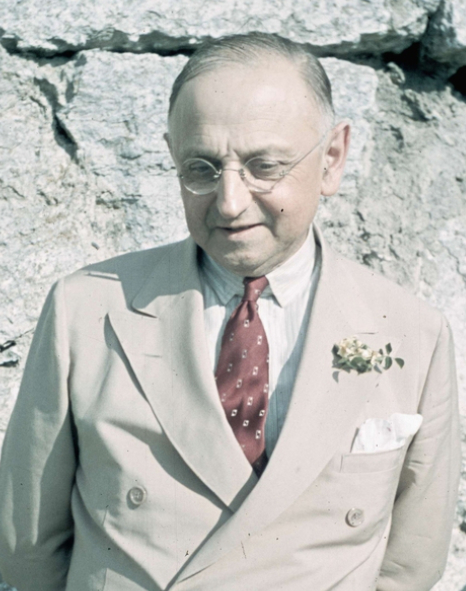

|
Silkworth: The Little Doctor Who Loved Drunks by Dale Mitchel, published by Hazelden - (not hosted on this site) |

|
Father Ed Dowling - 1955 at the AA International Convention in St Louis, MO introduced by Bill Wilson. |
Anne Hermann Bingham (1899 - 1984)
The co-founder of Al-Anon with Lois Wilson. At 19 Anne married Devoe Bingham in 1918. Devoe ran a garage and sold foreign automobiles. They were married for many years before Devoe took his first drink at the age of 30. The first time he drank he never made it back home that night. Devoe was admitted four times to Towns Hospital and spent 10 years in AA before he maintained sobriety. During this time Anne would turn to Lois Wilson for help, in the process they became close friends and helped one another. Lois and Bill along with Anne and Devoe spent many Saturday evenings together. In the beginning days Anne would travel from her home in Chappaqua to Stepping Stones, carrying her personal typewriter. Lois and Anne made many trips together speaking to groups and events around the country. When the Clearing House came into existence Anne became the chairman of the Prisons Groups Committee, which later became the Institutions Committee. When an inmate would write to AA asking that their families be given help, the request would be passed to the Clearing House. Anne would write to the families of inmates and also contact the warden of the institution educating them about Al-Anon. Devoe died unexpectedly in 1961 with ten years of sobriety. After his death Anne married Bill's cousin Howard Wilson, and they moved to Connecticut where they attended AA meetings. The marriage lasted only a few years, and Anne then moved a few times around the country. She lived in Florida for six years, where she helped establish Al-Anon meetings there. The last time Anne and Lois were together was at the 1983 at an AA DAAR Convention in Palm Springs, California. Anne died on 6 March 1984 and is buried next to Devoe in Chappaqua, NY. (information from the books "First Steps: Al-Anon 35 years of Beginnings" and "Lois Remembers" and findagrave.com
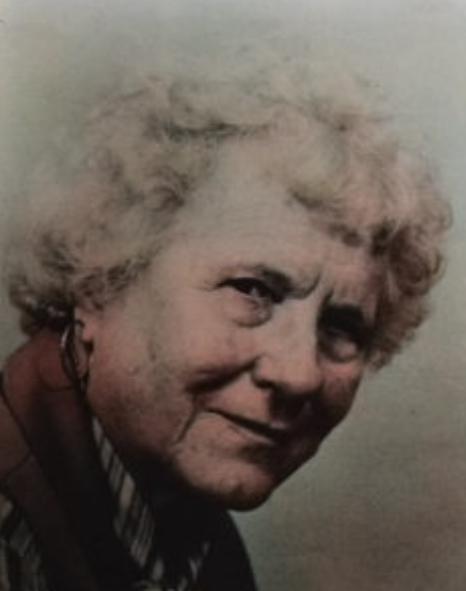
Co-founder of Al-Anon

|
Anne Bingham Co-founder of Al-Anon last talk - Desert Roundup - Palm Springs ~ 3 June 1983 |
Emmet Fox (1886-1951)
Emmet Fox was an Irish emigrant and pastor of a large church in New York City. He became popular during the Depression era, with services of 5,000+ attendees. Fox’s secretary was the mother of one of one of the men that Bill Wilson worked with in the early days. As a result of this connection, early AA groups often went to hear Fox. Emmet Fox emphasized the idea that thoughts are real things, and that one cannot have one kind of mind and another kind of life. According to Fox, if we want to change our lives, then we must change our thoughts first. His writing, especially "The Sermon on the Mount", became popular in AA. Several pamphlets "The Golden Key," and "The Seven Main Aspects of God" are also widely read by early AA's.
Fox deals with resentments and forgiveness in the booklet titled "The Lord's Prayer". Here is an excerpt "Setting others free means setting yourself free, because resentment is really a form of attachment. It is a Cosmic Truth that it takes two to make a prisoner; the prisoner - and the jailer. There is no such thing as being a prisoner on one's own account. Every prisoner must have a jailer, and the jailer is as much a prisoner as his charge. When you hold resentment against anyone, you are bound to that person by a cosmic link, a real, though mental chain. You are tied by a cosmic tie to the thing that you hate. The one person perhaps in the whole world whom you most dislike is the very one to whom you are attaching yourself by a hook that is stronger than steel. Is this what you wish? Is this the condition in which you desire to go on living? Remember, you belong to the thing with which you are linked in thought, and at some time or other, if that tie endures, the object of your resentment will be drawn again into your life, perhaps to work further havoc. Do you think that you can afford this? Of course, no one can afford such a thing; and so the way is clear, You must cut all such ties, by a clear and spiritual act of forgiveness. You must loose him and let him go. By forgiveness you set yourself free."
